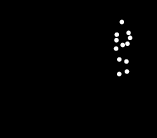

There are wider aspects. For instance the origin and significance of the arts become clearer from this viewpoint, as well as the origin and significance of science and mathematics and the nature of what we call intuition and creative imagination. The arts and sciences reflect a biological reality that explains their profound human importance. That reality includes the way perception works - as an unconscious model fitting process, an unconscious `science in miniature', as illustrated by the `walking lights' animation above - suggesting a simple yet coherent view of science itself, circumventing the usual philosophical debates and having far-reaching implications for the public understanding of science and, arguably, for future civilization.
The `walking lights' animation, a classic in experimental psychology, shows how perception works by model fitting. Here the sparseness of the data makes the point more evident than usual: the significant data are the positions of a mere 12 moving points in a two-dimensional space (represented on the retinas of your eyes). One of the viewer's unconscious modelling assumptions is that the data come from a three-dimensional object that is `piecewise rigid', with distances between the visible points invariant. I am indebted to James Maas for kindly supplying these data, in analogue form, from experimental work initiated by Gunnar Johansson, and to Stuart Dalziel, Steve Lay, and Nicholas Pinhey for valuable assistance with the digitizing and processing. The playback speed may vary from computer to computer, but is usually somewhere within the range of real walking speeds. Several files playing at different speeds are available on my anonymous ftp site; all the filenames begin with the characters lucidity-walking-lights
Here are links to lucidity principles in brief (17K) and to my draft-revision toolkit (2K).